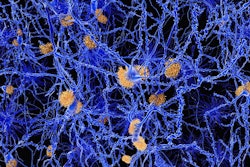
A new nanomaterial that can pass through the blood-brain barrier and be visualized with MRI and near-infrared imaging could facilitate the early detection of Alzheimer's disease, according to researchers at Hong Kong Baptist University (HKBU) in Hong Kong.
 Near-infrared imaging of the brain of normal (upper row) and Alzheimer's-affected mice (bottom row) before and after injection of the new nanomaterial. The red color indicates the presence of plaques. Image courtesy of HKBU.
Near-infrared imaging of the brain of normal (upper row) and Alzheimer's-affected mice (bottom row) before and after injection of the new nanomaterial. The red color indicates the presence of plaques. Image courtesy of HKBU.The group led by Ricky Wong Man-shing, PhD, and Li Hung-wing, PhD, developed a new nanomaterial that specifically targets beta-amyloid plaques, which are associated with Alzheimer's disease. The nanomaterial -- fabricated by combining superparamagnetic iron oxide nanoparticles and cyanine compounds -- fluoresces after binding to these plaques. It can then be easily detected by MRI and near-infrared imaging systems, according to the researchers.
"The fact that the new nanomaterial we have discovered is nonradioactive, nontoxic, and able to penetrate the blood-brain barrier shows its promise for use in near-infrared imaging (NIRI) and MRI scanning of the brain," Wong said in a statement from HKBU. "As a result, its application as a contrast agent for imaging is highly important and could lead to earlier detection -- and improved monitoring -- of Alzheimer's disease."
The researchers shared their work in an article published online July 12 in Small.



.fFmgij6Hin.png?auto=compress%2Cformat&fit=crop&h=100&q=70&w=100)




.fFmgij6Hin.png?auto=compress%2Cformat&fit=crop&h=167&q=70&w=250)











